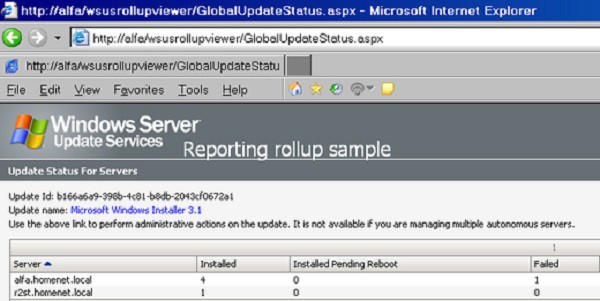
Add Kb Update To Wsus Server Diagnostic Tool
Sep 8, 2016 - WSUS running updates are downloading and approved, I made tests on two. I tried several handling such as installation of KB or remove the registry key. WSUS Client Diagnosting Tool utility displays the message to me. WSUS server, I changed the setting in my GPO add FQDN instead of the name. There are a few command-line tools that can help you identify problems, query for information, or speed up the detection update process. The following is a list of these tools: WSUS Client Diagnostics Tool (ClientDiag.exe) Downloadable from Microsoft's Web site.
Skype Last week we paused the rollout of the Windows 10 October 2018 Update (version 1809) for all users as we investigated isolated reports of users missing files after updating. Given the serious nature of any data loss, we took the added precaution of pulling all 1809 media across all channels, including Windows Server 2019 and IoT equivalents. We intentionally start each feature update rollout slowly, closely monitoring feedback before offering the update more broadly. In this case the update was only available to those who manually clicked on “check for updates” in Windows settings. At just two days into the rollout when we paused, the number of customers taking the October 2018 Update was limited. 
While the reports of actual data loss are few (one one-hundredth of one percent of version 1809 installs), any data loss is serious. We have fully investigated all reports of data loss, identified and fixed all known issues in the update, and conducted internal validation. Also, Microsoft Support and our retail stores customer service personnel are available at no charge to help customers.
More details are available below. Today we take the next step towards the re-release of the Windows 10 October 2018 Update by providing the updated version to our Windows Insider community. We will carefully study the results, feedback, and diagnostic data from our Insiders before taking additional steps towards re-releasing more broadly. More Information Prior to re-releasing the October 2018 Update our engineering investigation determined that a very small number of users lost files during the October 2018 Update. This occurred if Known Folder Redirection (KFR) had been previously enabled, but files remain in the original “old” folder location vs being moved to the new, redirected location. KFR is the process of redirecting the known folders of Windows including Desktop, Documents, Pictures, Screenshots, Videos, Camera Roll, etc.
From the default folder location, c: users username, to a new folder location. In previous feedback from the Windows 10 April 2018 Update, users with KFR reported an extra, empty copy of Known Folders on their device. Based on feedback from users, we introduced code in the October 2018 Update to remove these empty, duplicate known folders. That change, combined with another change to the update construction sequence, resulted in the deletion of the original “old” folder locations and their content, leaving only the new “active” folder intact.
Accordingly, below are the issues we have identified and fixed: • Using KFR the user redirected a known folder to a different drive. For example, suppose you ran out of space on your C drive. You want to save some files separate from your primary folder, so you add another drive to your system for these. You create “D: documents” and change the location of the files known folder from the original “old” location c: users username documents to D: documents. In some cases, if the contents of c: users username documents were not moved to D: documents, then a user could also encounter this issue.
When the October 2018 Update was installed the original “old” folder was deleted including the files in that folder (in this example c: users username documents would be deleted; d: documents, the new location, would be preserved). • The user configured one or more of their Known Folders (Desktop, Documents, Pictures, Screenshots, Videos, Camera Roll, etc.) to be redirected (KFR) to another folder on OneDrive. For example, the user changed the location property of the documents folder from c: users username documents to another folder. During this process the system prompts the user and asks if they would like to move the files to the new location. If the files were not moved and the October 2018 Update is installed the original “old” folder was deleted including the files in that folder. • The user used an early version of the OneDrive client and used the OneDrive settings to turn on the Auto save feature. This feature turned on KFR for the Documents and/or Pictures folders based on the user’s choice but did not move the existing files from the original “old” location to the new location.